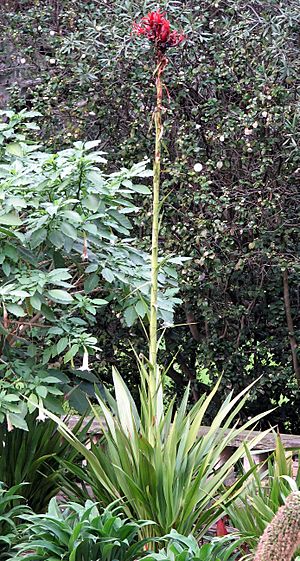Gymea lily facts for kids
Quick facts for kids Gymea lily |
|
|---|---|
 |
|
| Gymea lily in the Royal Botanic Gardens, Sydney | |
| Scientific classification | |
| Genus: |
Doryanthes
|
| Species: |
excelsa
|
| Synonyms | |
|
|
The gymea lily, also known by its scientific name Doryanthes excelsa, is a beautiful flowering plant. It belongs to the family called Doryanthaceae. This plant is special because it is endemic to a small area. This means it only grows naturally in coastal parts of New South Wales near Sydney, Australia.
The gymea lily has long, sword-like leaves that can be over 1 metre (3 feet) long. It also grows a very tall flower spike, which can reach up to 6 metres (20 feet) high! At the top of this spike, you'll find a large bunch of bright red flowers. Each flower is about 10 centimetres (4 inches) wide. The name "gymea" comes from the Eora people, who are the original inhabitants of the Sydney area. In fact, two Sydney suburbs, Gymea and Gymea Bay, are named after this amazing lily.
Contents
What Does the Gymea Lily Look Like?
Gymea lilies grow in a special shape called a rosette. This means their many sword-shaped leaves spread out from a central point, like the petals of a rose. These leaves are long and strap-like, usually between 1 and 2.5 metres (3 to 8 feet) long. They are also about 10 centimetres (4 inches) wide. The leaves are bright green, strong, and smooth, meaning they have no hairs.
In winter, a tall flower spike starts to grow from the middle of the plant. This spike can grow up to 6 metres (20 feet) tall. It has shorter leaves on it, up to 30 centimetres (12 inches) long. At the very top of the spike, a large head of flowers forms. This flower head can be 30 centimetres (12 inches) across. Each flower is bright red and shaped like a trumpet, about 10 centimetres (4 inches) long. The flower head is surrounded by reddish-brown leaf-like parts called bracts. Sometimes these bracts can make it a bit hard to see the bright flowers from the ground.
The gymea lily usually flowers in spring. After the flowers, oval-shaped, reddish-brown seed pods appear. These pods are about 7 to 10 centimetres (3 to 4 inches) long. In late summer, the pods split open. This releases the seeds, which are about 15 to 23 millimetres (0.6 to 0.9 inches) long.
How the Gymea Lily Got Its Name
The scientific name for the gymea lily is Doryanthes excelsa. It was first officially described in 1802 by a Portuguese expert named José Correia da Serra. He studied a plant sample collected by George Bass in the mountains of New South Wales.
The name Doryanthes comes from two Ancient Greek words. "Dóry" means "spear," and "ánthos" means "a flower." This name perfectly describes the plant's tall, spear-like flower spike. The second part of the name, excelsa, is a Latin word. It means "high," "lofty," or "distinguished," which also fits the plant's impressive height.
The Doryanthes excelsa and another plant called Doryanthes palmeri are the only two types of plants in the Doryanthaceae family.
Where the Gymea Lily Lives
The Doryanthes excelsa grows in woodlands and dry sclerophyll forests. These are types of forests found along the coast and in nearby mountains. You can find them from Karuah down to Mount Keira in New South Wales. They usually grow in soils that come from sandstone rocks.
How People Use the Gymea Lily
Traditional Indigenous Use
Aboriginal people have used the gymea lily for a long time. They would roast the young stems of the plant to eat them. They also roasted the roots and made them into a type of cake. The strong fibres from the leaves were used to make useful items. These included brushes and mats.
Growing Gymea Lilies in Gardens
Gymea lilies are tough and can adapt to different conditions. This makes them popular plants for gardens and parks. They are often used in areas like Sydney, Brisbane, and Perth. You can grow new plants from seeds. However, it might take up to eight years for a plant grown from seed to flower for the first time.
There are some interesting ways to encourage the lily to flower. Sometimes, fire can help them bloom. Also, carefully placing a stone in the centre of the plant's rosette can encourage flowering.
Image gallery
-
Australian native growing in Heathcote National Park, Sydney









